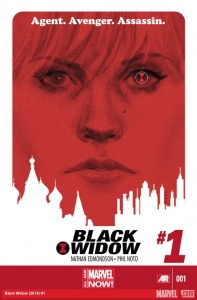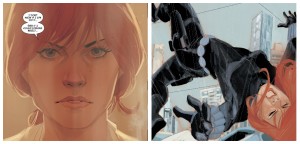 2014 heralds the return of solo titles for two characters I have long been a fan of. In February, She-Hulk hits the racks, with what looks to be a promising new series. First off though, Black Widow is in the spotlight, continuing the trend of character focused, intensely personal solo arcs that kicked off with Matt Fraction’s Hawkeye in 2012.
2014 heralds the return of solo titles for two characters I have long been a fan of. In February, She-Hulk hits the racks, with what looks to be a promising new series. First off though, Black Widow is in the spotlight, continuing the trend of character focused, intensely personal solo arcs that kicked off with Matt Fraction’s Hawkeye in 2012.
With the more subtle theme of loneliness and isolation undercutting Natasha Romanova’s quest for atonement, and Phil Noto’s delicate, almost retro art style, the whole book feels like a bleak seventies thriller. Exactly the tone I expected from a book aiming to be unique, despite clear influences from titles such as Hawkeye and Captain Marvel. It’s an engaging, violent, and visually stunning book, that in two issues has already earned a permanent space on my pull list.
The first issue is classic set-up and exposition, introducing Widow to newer readers in a way that doesn’t feel forced or tedious to those who are already familiar with (at least some) of her long and complex story. As someone who hasn’t read any of Nathan Edmonson’s previous work, this was a pleasant surprise. Introductions are made, motivations are set, and like the influential titles mentioned above, something resembling a normal home life is established.
Issue two moves straight on from the set-up, and headlong into a deeper exploration of Natasha’s motivation, while also offering an insight into the man aiding her quest – apparently unassuming lawyer Isaiah. Isaiah’s story is a more subtle, understated contrast, inter-cut throughout Natasha’s overt, public fight with the main villain of the issue. Issue two also cements the idea of home, something we perhaps may not have associated with Black Widow in the past, with a return to her apartment in the final scene.
 While the writing here is solid, the real star of the show is Phil Noto’s magnificent, elegant artwork. His style is fine and almost fragile, ideas I had perhaps not associated with Natasha in the past, but it fits so perfectly here. Noto’s colours effectively convey tone, and the washed out, muted look of the whole book really gives it the feel of that seventies espionage thriller. His consistency with character design, sketchy, movement filled panels, and ability to convey emotion are what elevate Black Widow from very good, to excellent.
While the writing here is solid, the real star of the show is Phil Noto’s magnificent, elegant artwork. His style is fine and almost fragile, ideas I had perhaps not associated with Natasha in the past, but it fits so perfectly here. Noto’s colours effectively convey tone, and the washed out, muted look of the whole book really gives it the feel of that seventies espionage thriller. His consistency with character design, sketchy, movement filled panels, and ability to convey emotion are what elevate Black Widow from very good, to excellent.
My only hesitation is that I feel like this is the film we should have had. Marvel has taken a risk in giving Natasha her own solo – and that’s great – but when are they going to take that leap from page to screen? Black Widow is a wonderful, grim, introspective look at a character still surrounded by a lot of mystery, despite her long history in Marvel Comics canon. Could this book be the test run for a Black Widow film? I sure hope so.
 RSS - Posts
RSS - Posts
Recent Comments